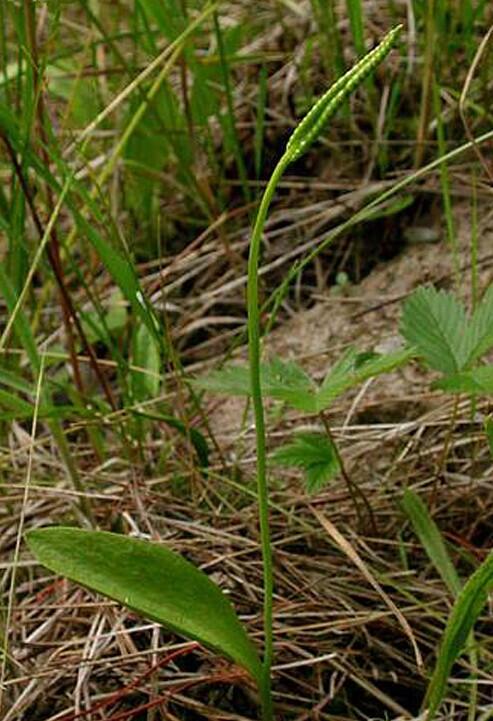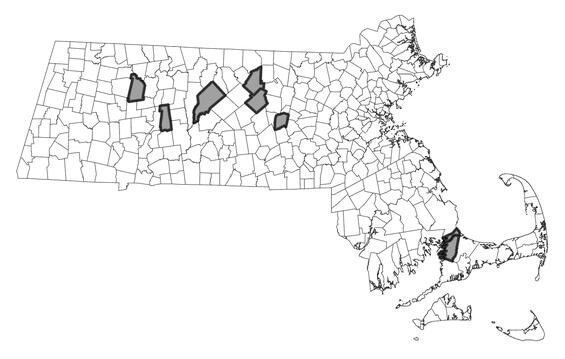- Scientific name: Ophioglossum pusillum
- Species of Greatest Conservation Need (MA State Wildlife Action Plan)
- Threatened (MA Endangered Species Act)
Description

Adder’s Tongue Fern (Ophioglossum pusillum)
Adder’s tongue fern, Ophioglossum pusillum, is a small perennial, terrestrial fern, up to 30 cm (12 in) high, consisting of a single fleshy dull green stalk (stipe) bearing a simple leaf and a fertile spike. The stipe arises from fleshy, corm-like rhizomes and roots. About midway up the stipe is the pale green leaf, approximately 15 cm (6 in), narrowly oval to oblong. The blade gradually tapers for about 1/3 to 2/3 of its length to a narrow, 1-2 cm (0.4-0.8 in) base that continues to run down the lower stipe. There is a finely indented network of interconnecting veins. The stipe extends well beyond the leaf blade and is terminated by a short, pale green, narrow fertile spike 1-4 cm (0.4-1.6 in) long and up to 5 mm wide, which consists of 2 tightly packed rows of 10 to 30 pairs of rounded sporangia (spore cases) on the margins of the spike axis. There can be a large variation in the size, shape, and position of the blade, as well as of the fertile spike; occurrences of two fronds (leaves) per rootstalk have been observed. The plant appears anytime after early June.
No other fern looks like the adder’s tongue fern. Its closest relatives, the grape ferns (Botrychium spp.) have dissected or lobed leaves. Several orchids and lilies may have similarly shaped fleshy basal leaves, such that non-flowering or juvenile individuals may at first glance be mistaken for adder’s tongue fern. However, all have parallel-veined leaves, rather than net-veined as adder’s tongue fern is.
Life cycle and behavior
All ferns have two generations in their life cycle. One is haploid (gametophyte) and the other is a diploid (sporophyte) phase. The sporophyte generation is the one which produces the green leaves that we see and produces spores from its fertile frond. Leaves of adder’s tongue fern appear in mid-spring but may be confused with an orchid if it does not have a fertile sporophore. The fertile sporophore may appear in early July until mid-September. The spores will turn brown when mature. Not all plants produce fertile sporophores. Adder’s tongue fern also produces additional ramets via branching underground rhizomes (McMaster, 1996) which can lead to small colonies with limited genetic variability (McMaster, 1994). The haploid gametophytes occur only underground, have no chlorophyll and rely on arbuscular mycorrhizal fungi for its nutrition (Field et al. 2015). The developing sporophyte also relies on the same fungi for its nutritional needs. Field et al. (2015) identified the arbuscular mycorrhizae fungi as Glomus macrocarpum.
Population status
Adder’s tongue fern is listed as threatened under the Massachusetts Endangered Species Act. All listed species are protected from killing, collecting, possessing, or sale and from activities that would destroy habitat and thus directly or indirectly cause mortality or disrupt critical behaviors. It was once a widespread species in Massachusetts during the century of extensive agricultural clearing. Records prior to 1978 are from over 90 locations! At present there are only 8 known occurrences, verified since 1999. This elusive and easily overlooked species makes it difficult to determine whether individual populations are in decline or stable. Historically, the species is known from every county in Massachusetts; it is currently known only from Barnstable, Franklin, Hampshire and Worcester counties.
Distribution and abundance
Adder’s tongue fern is a very widespread, primarily northern fern occurring across North America from Prince Edward Island and southern Manitoba and British Columbia; south to Virginia and west to Wyoming and Montana, and along the Pacific coast to California. It previously was known from Alaska but is presumed extirpated from both Alaska and Virginia. In every state and province that has assessed adder’s tongue fern, it is of conservation concern except in Ontario, where it is apparently secure. In New England, adder’s tongue fern is critically imperiled in Connecticut, Maine, New Hampshire, Rhode Island and Vermont. It is imperiled in Massachusetts.

Distribution in Massachusetts. 1999-2024. Based on records in the Natural Heritage Database.
Habitat
Boggy meadows, acidic fens (sphagnous areas with seeping groundwater), borders of marshes, wet fields, and moist woodland clearings provide suitable open and sunny habitat for adder’s tongue fern. Vegetation in these habitats is varied, composed predominantly of common grasses, bulrushes (Scirpus), sedges (Carex), and broadleaved herbs including ragged, small purple fringed, and white fringed orchis (Platanthera lacera, P. psycodes, and P. blephariglottis), and swamp milkweed (Asclepias incarnata). No common associate or indicator species particularly point to the presence of adder’s tongue fern.
Healthy habitats are vital for supporting native wildlife and plants. Explore habitats and learn about conservation and restoration in Massachusetts.
Threats
Adder’s tongue fern appears to need the increased light from canopy opening or forest clearing. Reports from most of the current sites mention threats from succession. Invasive species are impinging on several of the populations; removal of invasive plants would leave space and less shade for the fern. Changes in hydrology are likely to impact populations of adder’s tongue fern. Logging with heavy equipment that causes major soil disturbance in adder’s tongue fern is likely to be detrimental to the species. This species is decreasing across its range, and the specific cause(s) are not known, and climate changes may be impacting the species as well.
Conservation
Surveys are clearly needed for this species, including surveys of potential habitats where the species is not currently known. The best time to survey is once the sporophore is produced in July through mid-September. Notes on the condition of the habitat are needed as part of the assessment and survey of the species.
Several of the sites are mowed fields; recommendations in those cases are for single yearly mowings to take place in the spring to allow the plant to grow and produce spores. All active management of rare plant populations (including invasive species removal) is subject to review under the Massachusetts Endangered Species Act and should be planned in close consultation with the MassWildlife's Natural Heritage and Endangered Species Program.
There are many gaps in our knowledge about adder’s tongue fern. Primary among them are reasons why the species is decreasing across its entire range. Is it due to climate change and warmer temperatures? Is it due to a decrease in its fungal associates? Research is needed to determine whether this plant can be grown in a nursery or garden setting for purposes of reintroductions. If habitat degradation accelerates losses of current populations, this strategy could prove useful to long-term conservation of this species.
Contact
| Date published: | May 9, 2025 |
|---|